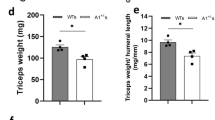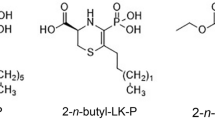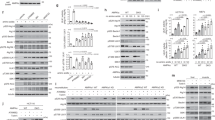Abstract
Background:
Sepsis induces loss of skeletal muscle mass by activating the ubiquitin proteasome (UPS) and autophagy systems. Although muscle protein synthesis in healthy neonatal piglets is responsive to amino acids (AA) stimulation, it is not known if AA can prevent the activation of muscle protein degradation induced by sepsis. We hypothesize that AA attenuate the sepsis-induced activation of UPS and autophagy in neonates.
Methods:
Newborn pigs were infused for 8 h with liposaccharide (LPS) (0 and 10 μg·kg−1·h−1), while circulating glucose and insulin were maintained at fasting levels; circulating AA were clamped at fasting or fed levels. Markers of protein degradation and AA transporters in longissimus dorsi (LD) were examined.
Results:
Fasting AA increased muscle microtubule-associated protein light 1 chain 3 II (LC3-II) abundance in LPS compared to control, while fed AA levels decreased LC3-II abundance in both LPS and controls. There was no effect of AA supplementation on activated protein kinase (AMP), forkhead box O1 and O4 phosphorylation, nor on sodium-coupled neutral AA transporter 2 and light chain AA transporter 1, muscle RING-finger protein-1 and muscle Atrophy F-Box/Atrogin-1 abundance.
Conclusion:
These findings suggest that supplementation of AA antagonize autophagy signal activation in skeletal muscle of neonates during endotoxemia.
Similar content being viewed by others
Log in or create a free account to read this content
Gain free access to this article, as well as selected content from this journal and more on nature.com
or
References
Lecker SH, Goldberg AL, Mitch WE. Protein degradation by the ubiquitin-proteasome pathway in normal and disease states. J Am Soc Nephrol 2006;17:1807–19.
Bruins MJ, Deutz NE, Soeters PB. Aspects of organ protein, amino acid and glucose metabolism in a porcine model of hypermetabolic sepsis. Clin Sci (Lond) 2003;104:127–41.
Verbruggen SC, Coss-Bu J, Wu M, et al. Current recommended parenteral protein intakes do not support protein synthesis in critically ill septic, insulin-resistant adolescents with tight glucose control. Crit Care Med 2011;39:2518–25.
Orellana RA, Kimball SR, Nguyen HV, et al. Regulation of muscle protein synthesis in neonatal pigs during prolonged endotoxemia. Pediatr Res 2004;55:442–9.
Lang CH, Frost RA, Vary TC. Regulation of muscle protein synthesis during sepsis and inflammation. Am J Physiol Endocrinol Metab 2007;293:E453–9.
Joffe A, Anton N, Lequier L, et al. Nutritional support for critically ill children. Cochrane Database Syst Rev 2009;15;CD005144.
Escobar J, Frank JW, Suryawan A, et al. Physiological rise in plasma leucine stimulates muscle protein synthesis in neonatal pigs by enhancing translation initiation factor activation. Am J Physiol Endocrinol Metab 2005;288:E914–21.
Suryawan A, Davis TA. Regulation of protein degradation pathways by amino acids and insulin in skeletal muscle of neonatal pigs. J Anim Sci Biotechnol 2014;5:8.
Orellana RA, O’Connor PM, Nguyen HV, et al. Endotoxemia reduces skeletal muscle protein synthesis in neonates. Am J Physiol Endocrinol Metab 2002;283:E909–16.
Orellana RA, Suryawan A, Wilson FA, et al. Development aggravates the severity of skeletal muscle catabolism induced by endotoxemia in neonatal pigs. Am J Physiol Regul Integr Comp Physiol 2012;302:R682–90.
Jamart C, Gomes AV, Dewey S, Deldicque L, Raymackers JM, Francaux M. Regulation of ubiquitin-proteasome and autophagy pathways after acute LPS and epoxomicin administration in mice. BMC Musculoskelet Disord 2014;15:166.
von Haehling S, Genth-Zotz S, Anker SD, Volk HD. Cachexia: a therapeutic approach beyond cytokine antagonism. Int J Cardiol 2002;85:173–83.
Wang C, Wang Y, McNutt MA, Zhu WG. Autophagy process is associated with anti-neoplastic function. Acta Biochim Biophys Sin (Shanghai) 2011;43:425–32.
Kabeya Y, Mizushima N, Ueno T, et al. LC3, a mammalian homologue of yeast Apg8p, is localized in autophagosome membranes after processing. EMBO J 2000;19:5720–8.
Béchet D, Tassa A, Combaret L, Taillandier D, Attaix D. Regulation of skeletal muscle proteolysis by amino acids. J Ren Nutr 2005;15:18–22.
Mizushima N, Yamamoto A, Matsui M, Yoshimori T, Ohsumi Y. In vivo analysis of autophagy in response to nutrient starvation using transgenic mice expressing a fluorescent autophagosome marker. Mol Biol Cell 2004;15:1101–11.
Mofarrahi M, Sigala I, Guo Y, et al. Autophagy and skeletal muscles in sepsis. PLoS One 2012;7:e47265.
Davis TA, Fiorotto ML, Burrin DG, et al. Stimulation of protein synthesis by both insulin and amino acids is unique to skeletal muscle in neonatal pigs. Am J Physiol Endocrinol Metab 2002;282:E880–90.
Davis TA, Fiorotto ML. Regulation of muscle growth in neonates. Curr Opin Clin Nutr Metab Care 2009;12:78–85.
Suryawan A, Nguyen HV, Almonaci RD, Davis TA. Abundance of amino acid transporters involved in mTORC1 activation in skeletal muscle of neonatal pigs is developmentally regulated. Amino Acids 2013;45:523–30.
Laufenberg LJ, Pruznak AM, Navaratnarajah M, Lang CH. Sepsis-induced changes in amino acid transporters and leucine signaling via mTOR in skeletal muscle. Amino Acids 2014;46:2787–98.
Anthony JC, Yoshizawa F, Anthony TG, Vary TC, Jefferson LS, Kimball SR. Leucine stimulates translation initiation in skeletal muscle of postabsorptive rats via a rapamycin-sensitive pathway. J Nutr 2000;130:2413–9.
Lynch CJ, Patson BJ, Anthony J, Vaval A, Jefferson LS, Vary TC. Leucine is a direct-acting nutrient signal that regulates protein synthesis in adipose tissue. Am J Physiol Endocrinol Metab 2002;283:E503–13.
Pham FH, Cole SM, Clerk A. Regulation of cardiac myocyte protein synthesis through phosphatidylinositol 3’ kinase and protein kinase B. Adv Enzyme Regul 2001;41:73–86.
Kimball SR, Jefferson LS. Molecular mechanisms through which amino acids mediate signaling through the mammalian target of rapamycin. Curr Opin Clin Nutr Metab Care 2004;7:39–44.
Neel BA, Lin Y, Pessin JE. Skeletal muscle autophagy: a new metabolic regulator. Trends Endocrinol Metab 2013;24:635–43.
Orellana RA, Jeyapalan A, Escobar J, et al. Amino acids augment muscle protein synthesis in neonatal pigs during acute endotoxemia by stimulating mTOR-dependent translation initiation. Am J Physiol Endocrinol Metab 2007;293:E1416–25.
Orellana RA, Suryawan A, Kimball SR, et al. Insulin signaling in skeletal muscle and liver of neonatal pigs during endotoxemia. Pediatr Res 2008;64:505–10.
Rathmacher JA, Nissen SL. Development and application of a compartmental model of 3-methylhistidine metabolism in humans and domestic animals. Adv Exp Med Biol 1998;445:303–24.
Wolfe RR, Jahoor F, Hartl WH. Protein and amino acid metabolism after injury. Diabetes Metab Rev 1989;5:149–64.
Suryawan A, Nguyen HV, Bush JA, Davis TA. Developmental changes in the feeding-induced activation of the insulin-signaling pathway in neonatal pigs. Am J Physiol Endocrinol Metab 2001;281:E908–15.
Acknowledgements
The authors thank Rosemarie Almonaci for technical support. This work is a publication of the U.S. Department of Agriculture/Agricultural Research Service Children’s Nutrition Research Center, Department of Pediatrics, Baylor College of Medicine. The contents of this publication do not necessarily reflect the views or policies of the U.S. Department of Agriculture, nor does the mention of trade names, commercial products, or organizations imply endorsement by the U.S. Government.
Author information
Authors and Affiliations
Corresponding author
PowerPoint slides
Rights and permissions
About this article
Cite this article
Hernandez-García, A., Manjarín, R., Suryawan, A. et al. Amino acids, independent of insulin, attenuate skeletal muscle autophagy in neonatal pigs during endotoxemia. Pediatr Res 80, 448–451 (2016). https://doi.org/10.1038/pr.2016.83
Received:
Accepted:
Published:
Issue date:
DOI: https://doi.org/10.1038/pr.2016.83



